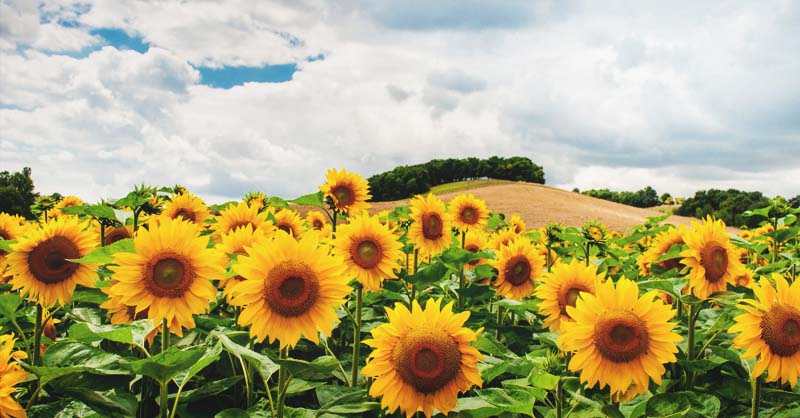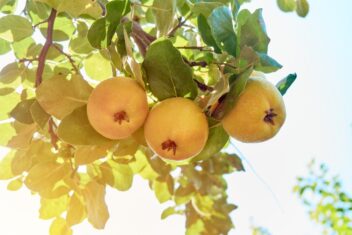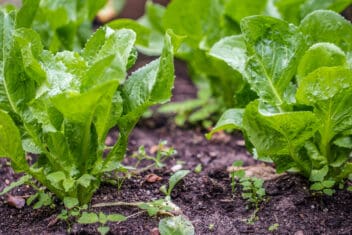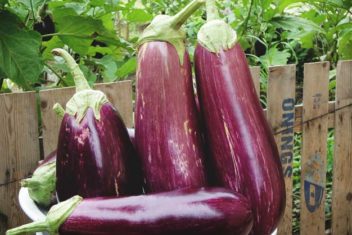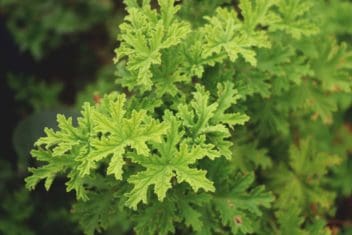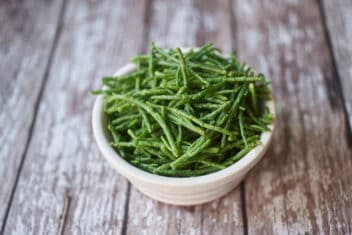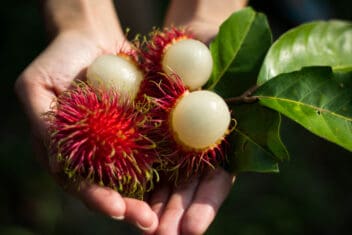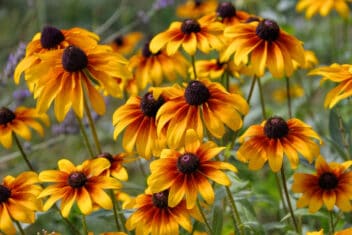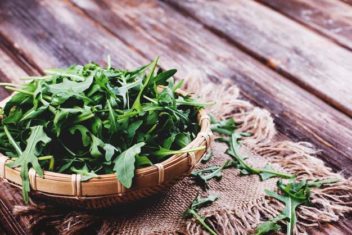Have you ever driven past a field of beautiful sunflowers growing in a row and thought, “I want that in my yard!”?
Think of all of the ways you can use a sunflower. They make beautiful bouquets, and they also produce seeds that make tasty snacks. On top of that, they’re perfect for attracting pollinators.
We can’t forget how many colors they add to your garden, as well.
Here’s everything you need to know to grow your own sunflower patch.
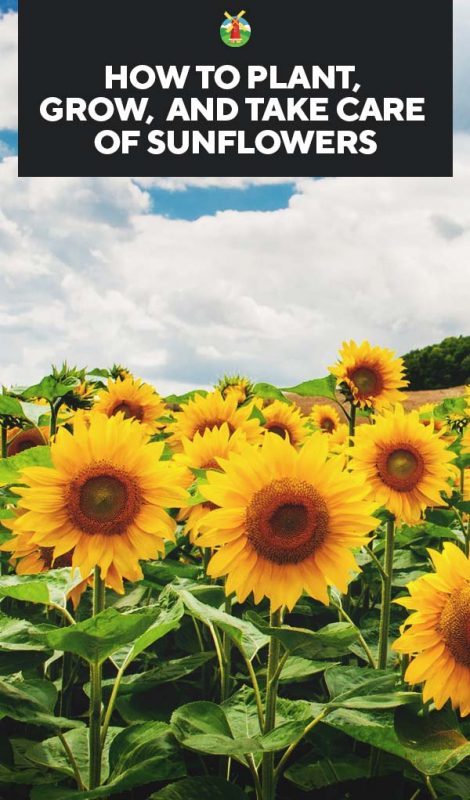
Sunflower Varieties
There are many different varieties of sunflowers. I’m going to share the most prominent ones with you, but as you shop for your seeds you may find other varieties that work well for your growing situation, too.
Giant Sungold
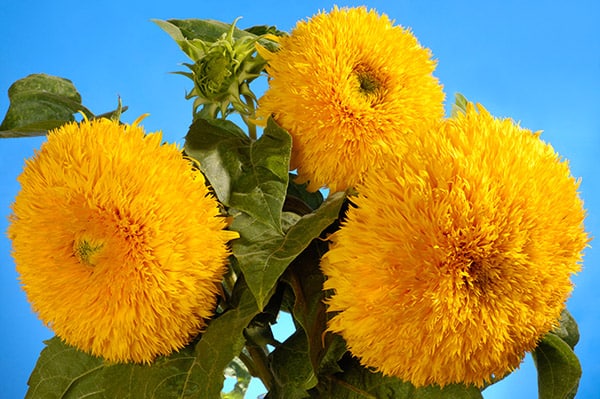
If you are in the market for a unique sunflower, the giant Sungold fits the bill. It’s known as a double bloomer sunflower.
It doesn’t look like a typical sunflower. Instead, its head is big and puffy like a dandelion. The plant stands six feet tall and the blooms reach eight inches across.
Strawberry Blonde

My favorite sunflowers are the multicolored varieties. I think their colors add something extra special to the garden. This variety is a multicolored sunflower that stands six feet tall. The tips are yellow, while the rest of the bloom is a reddish-pink.
Mammoth Russian
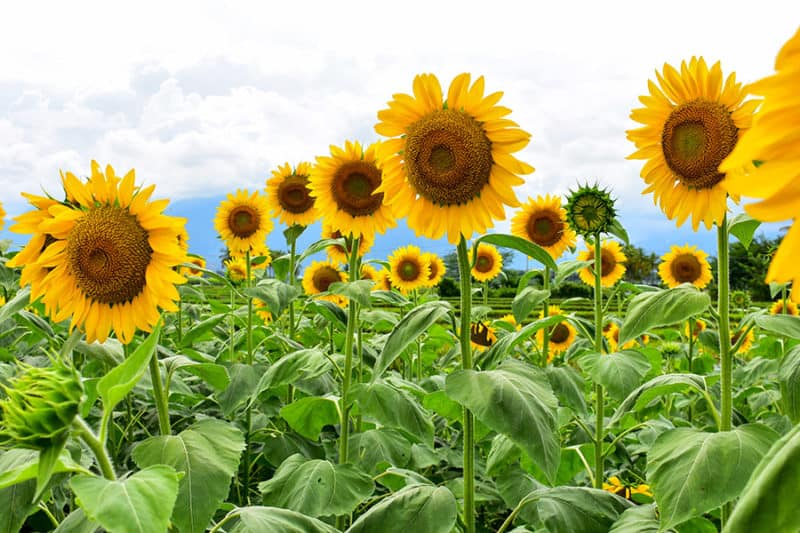
A lot of people grow sunflowers because of their sheer size. They’re hard not to notice when they get extremely tall and produce big, bold heads of color. This Mammoth Russian will grow to be a whopping 9-12 feet tall.
It also produces large, striped seeds that are easy to identify.
Italian White
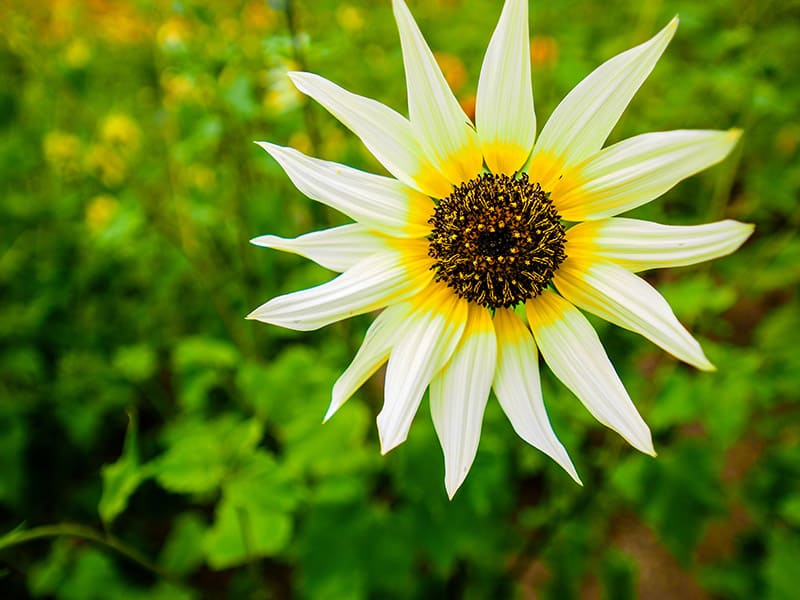
Do you prefer a lighter colored flower that stands tall but isn’t quite as flashy? If so, then you’ll love the Italian White. It grows four-inch white blooms but has a large dark-colored center.
This flower stands anywhere from 5-7 feet tall, and it produces multiple flowers throughout one growing season.
Little Becka
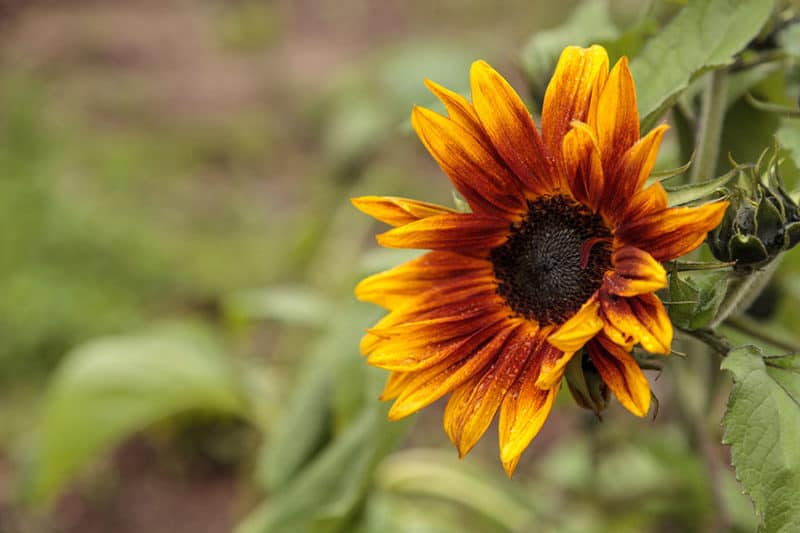
Some people really enjoy sunflowers but fear they don’t have the space to grow them. This variety solves that issue. Little Becka is a dwarf sunflower variety that only grows to be three feet tall
The blooms on this plant aren’t tiny, though. They grow to be six inches in width and are stunning. The colors start out as a golden, then transitions to a crimson red, and then back to gold at the base.
Moulin Rouge
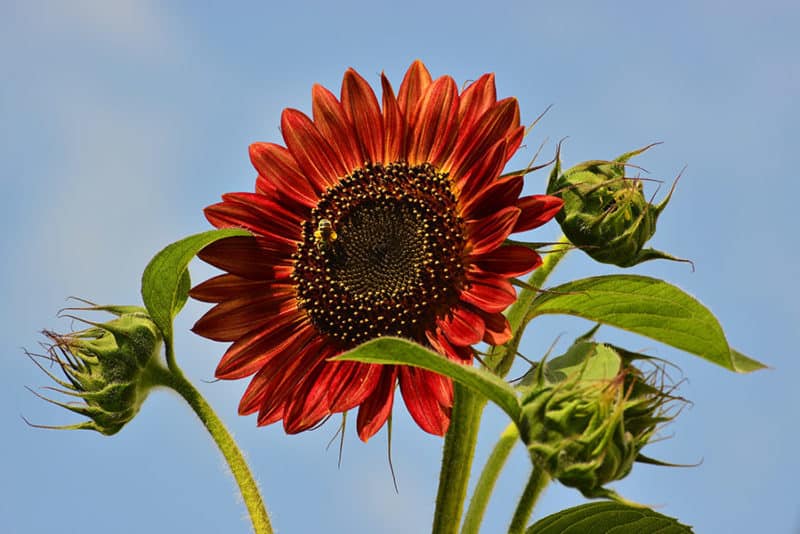
If you think red when you think moulin rouge, you’re correct. This is a darker colored sunflower with a dark red bloom that stands out. It’s a shorter variety of sunflower that only reaches four feet.
Soraya
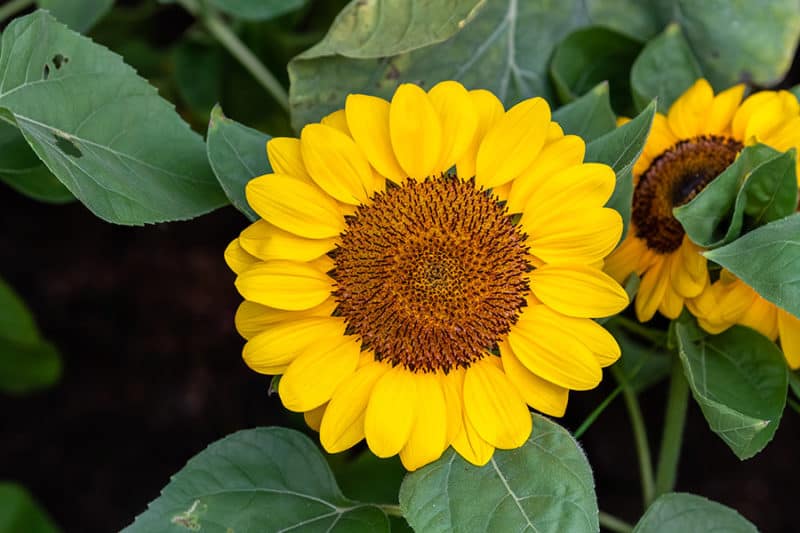
Do you shy away from sunflowers because of their tendency to fall over? This variety is for you. Soraya sunflowers are known for having large blooms and thick, sturdy stems that support its six-foot stature quite well.
Lemon Queen
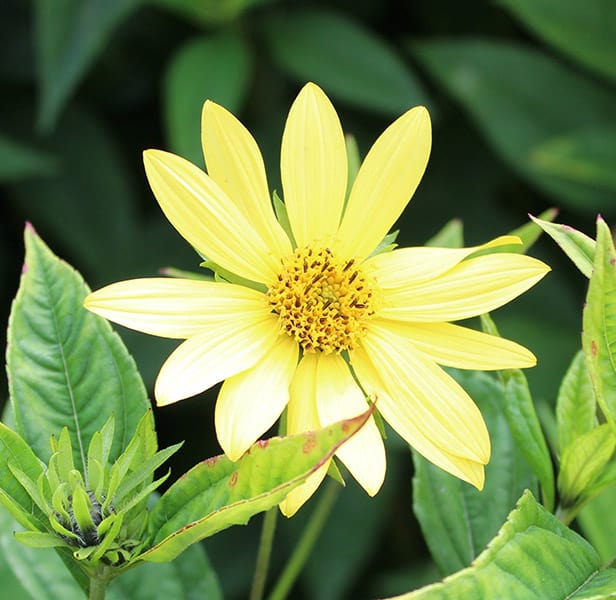
I mentioned in the opening how sunflowers are great for attracting pollinators. The Lemon Queen variety is known as the number one bee-attracting variety.
Super Snack Mix
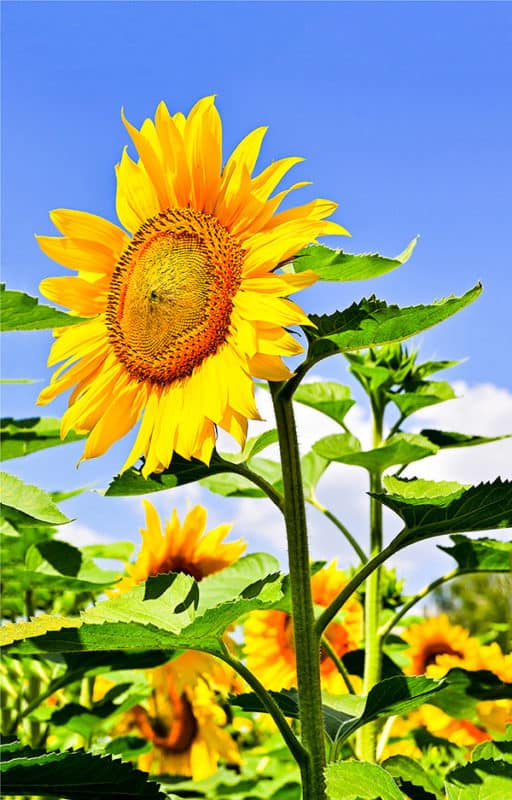
A lot of people grow sunflowers with the intent of eating the seeds. Super Snack Mix is a smart option for seed lovers since it produces large seeds that are easy to crack open and snack on.
This variety grows to be around six feet tall. It attracts bees and butterflies to your garden as well.
Taiyo

This variety is a Japanese heirloom variety that grows to be between 5-6 feet tall. They produce big heads with large centers that are most commonly used in flower arrangements.
How to Grow Sunflowers
Growing sunflowers requires a little forethought as to where you are going to plant them and some prepping of the soil. After that, you should be on your way to producing gorgeous sunflowers for the summer.
Sun Requirements
Plant sunflowers where they’ll get plenty of direct sunlight – they are called sunflowers, after all. The goal is to have roughly six to eight hours a day of direct sunlight.
Give Them the Right Soil
Make sure that you loosen up the soil two feet down and three feet wide where you are planning on planting. This ensures that the long taproots can spread out.
Mix fertilizer into the soil at least eight inches deep. You can use aged manure, compost, or chemical fertilizer.
Pick the Right Growing Area
Plant the sunflowers where they’ll have wind protection. This could be on the side of a building, or you could do what I do, which is to plant them along a fence line.
Sow the Seeds Outdoors
Directly sow the seeds into the prepped planting location after the last frost is finished. Make sure that the soil temperature is around 55-60°F. This is usually around the end of April or beginning of May in most locations.
Once you’ve got your seeds planted, you’ll want to add fertilizer to help the roots. You want to do all you can to encourage strong roots in your plants because the stronger they are the more difficult it will be for the wind to knock your sunflowers over.
Spacing
Once the soil is ready, sow the seeds into the ground, ensuring proper spacing. This means that your rows need to be 30 inches apart while the seeds in each row need to be planted six inches apart.
Make sure that you only plant the seeds one inch deep.
Plant in Pots
You can plant the dwarf varieties of sunflowers in pots. Be sure to give them well-drained, loose soil.
Also, be sure to put plenty of fertilizer in the soil to give the seeds what they need to grow.
Protect the Seeds and Seedlings
Watch out for birds and squirrels. They like to snatch your sunflower seeds and make a meal out of them.
If you find they’re a problem, purchase netting to protect your seeds until they’ve germinated and have begun to sprout.
Succession Planting
If you want to encourage continuous growth throughout the summer, wait until after the final frost, and then plant additional sunflower seeds every few weeks.
Be sure to stagger out the plantings. That way, when one planting is ready to stop producing, it’ll be time for the next planting to show its stuff.
Caring for Your Sunflowers
There are only a few main things you will need to do to help your plants have a healthy growing season.
Stake the Taller Varieties
The taller varieties of sunflowers need to be staked in order to avoid the stems from breaking.
Once the plant has reached half its eventual height, put a solid stake at an angle into the ground and tie it to the stem of your sunflower using bailing twine.
You don’t need a fancy stake. Bamboo or tobacco sticks will do the job.
Water Your Plants
Giving your sunflowers the right amount of water is vital. They need a different amount of water depending on their maturity level, but you need to be careful not to overdo it.
When your plants are still young, water at the root of the plant in a three to four-inch circumference. You should water when the soil around the plant is dry. If the soil is still damp, you run the risk of overwatering.
As the plant gets older and begins to hold its own, transition to watering only once per week unless there is an unseasonal amount of moisture or dryness. You’ll need to water more or less often in those cases.
When you water a more mature plant, put three to four gallons of water in the ground around the plant once a week.
Fertilize Sparingly
You did the majority of the fertilizing sunflowers need prior to planting them. Now, your goal is to not over-fertilize them.
If you fertilize your sunflowers one to two times per month, that should be plenty. You’ll need to be careful when doing this that you don’t allow the fertilizer to touch the base of the plant.
To do so, dig a circle around the plant and fill it with fertilizer. Then add water.
If you over-fertilize your plant, you run the risk of weakening the stem and your sunflowers may fall over.
Apply Mulch
By mulching around the base of your sunflowers, not only are you keeping weeds down, but you’re also helping the sunflowers to hold moisture in.
Though sunflowers handle drought well, this helps them to maintain the moisture they need to stay healthy.
But be sure to put a thick layer of mulch around the base of the sunflower. If it isn’t several inches thick, then it won’t do the job you need it to do.
Sunflower Problems and Solutions
Growing sunflowers is generally hassle-free for the most part. They do have a few things that can happen to them, but if you know what you are dealing with upfront, then the problem should be able to be corrected in a timely manner.
Rust
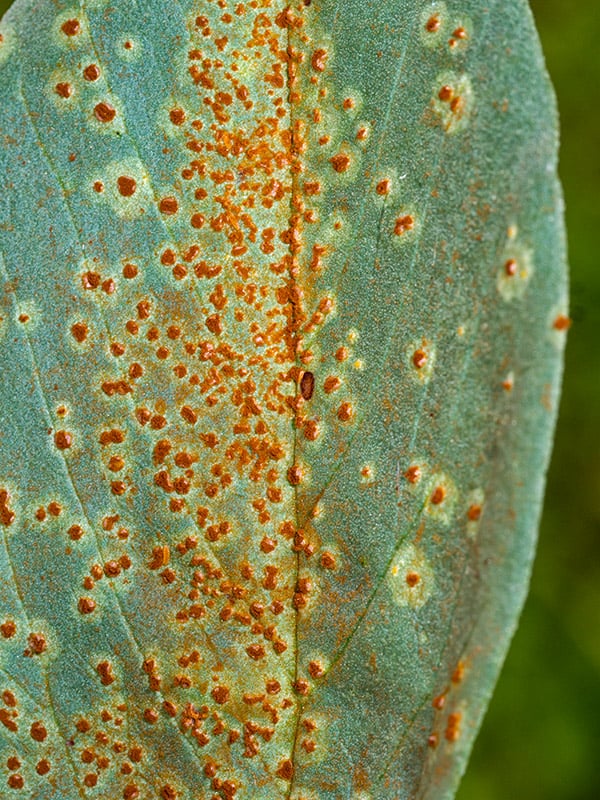
Rust looks exactly what it sounds like. You’ll see red and orange rust-like bumps and streaks, or yellow and white spots on the leaves. You’ll also begin to see leaves curl and look misshapen.
Rust usually doesn’t kill a plant, it just decreases the overall health of it.
Once rust develops, it’s difficult to get rid of. Begin by clearing out any debris in between your sunflowers. Remove any area impacted by it, and also make sure that you aren’t getting the leaves wet when watering.
Also, you can treat it with a copper fungicide as well. You can also take preventative measures by dusting your plants with sulfur, putting proper spacing between plants for airflow, and making sure not to get the leaves damp.
Powdery Mildew
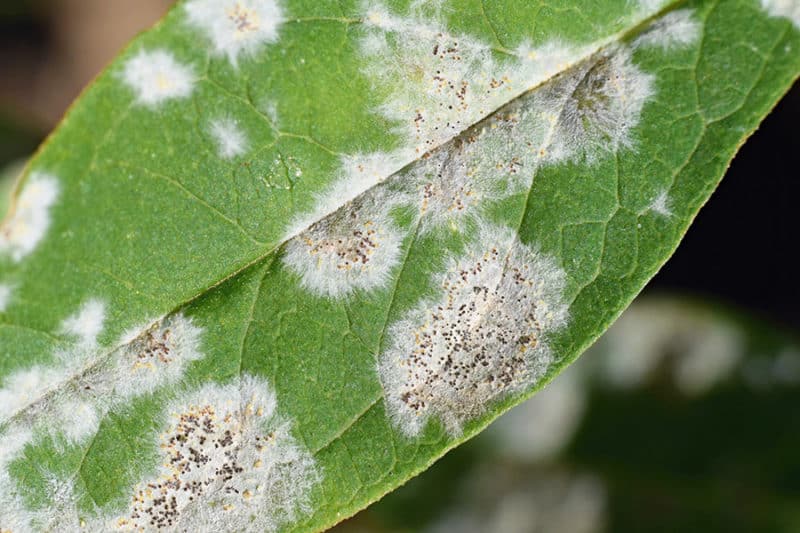
Powdery mildew is a fungus that makes the leaves of your plant look like they have been sprinkled with powdered sugar. The older leaves will often develop it first.
Powdery mildew can be treated with a fungicide and by removing any parts of the sunflower that have been infected.
Also, you can prevent this disease by not watering the sunflowers from overhead. Powdery mildew forms in humidity. If you can decrease humidity, then you can decrease your chances for this disease.
Leaf Mottle
Leaf mottle is a fungus that forms in the soil. There’s no cure, so rotate your crops in order to get rid of it.
Empty Seeds
Sunflower seeds have an outer casing that includes smaller seeds inside of it. If you open the casing and there is no seed, then you’ll know you have this problem.
Most often this happens when fall comes early. The best way to prevent this from happening is to plant earlier.
Downy Mildew
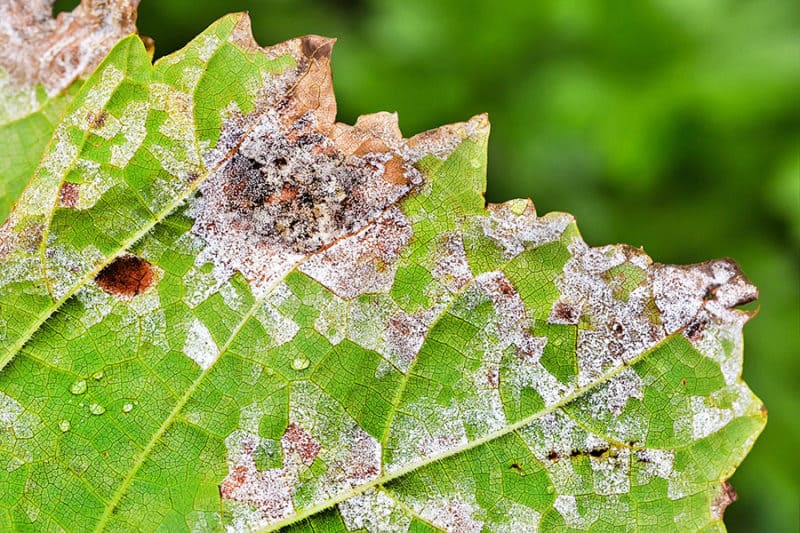
Downy Mildew is a fungus that has a blue tint to it. It forms on the bottom side of the leaves.
You will have to use a fungicide to treat downy mildew, as you do with any other fungus. However, if you don’t like the idea of using a fungicide on your plants, then try mixing one teaspoon of baking soda per one quart of water and spraying it on the impact plant parts.
Birds and Squirrels
Birds and squirrels will try to eat your seeds when they are first planted, as I mentioned above. Your plants will be safe during sprouting, but once they form heads, they are up for grabs again. They need protection.
Cover the newly planted seeds with netting to keep them from being eaten. The mature sunflower heads need to be covered as well.
You can use items you may already have on hand, such as a cheesecloth or pantyhose.
Deer
Deer will graze in your yard if they think you have a source of food for them. You’ll need to prevent them from entering your property by using proper fencing.
Moths
Moths are not a huge threat when growing sunflowers, though certain moths will try to lay their eggs on the blossoms of your sunflowers. Pick the worms off of your sunflowers when you see them.
Best and Worst Companion Plants
The best companion plants for sunflowers are:
- Bush beans
- Squash
- Cucumbers
- Corn
- Lettuce
- Any plant infested by aphids
Bush beans are a great companion plant because they produce their own nitrogen which means that they and sunflowers won’t be competing for nutrients in the soil.
Also, sunflowers are great to use as natural trellises to support cucumbers and corn. Sunflowers also provide necessary shade that cucumbers and lettuce desire.
Finally, any plant that can become easily infected with aphids is a great candidate to plant around sunflowers because sunflowers are known for being hearty and having thick stalks. This is hard on aphids and discourages them from coming around.
The worst companion plant for sunflowers is potatoes. When you plant sunflowers and potatoes near one another they will work against each other and cause stunted growth.
How to Harvest and Store Sunflowers
Harvesting and storing your sunflowers and seeds is a simple process. You can do multiple things with sunflowers, and we are going to cover them all:
Harvest for Bouquet
If you’re growing sunflowers in hopes of having beautiful fresh-cut bouquets for little money, then you’ll need to know the proper way to harvest them.
Begin by scoping your sunflower out. You’ll need to keep an eye out as to when it appears that a flower head could potentially bloom.
Then, you’ll want to cut the main stem that is holding the head before the flower has bloomed. This will encourage additional side blooms.
Cut your flowers in the morning to discourage them from wilting. Make sure that you put the sunflowers in tall vases in order to give them support.
Finally, you’ll want to make sure that you give them fresh water daily. This can help them last a week or more.
Harvest Sunflower Seeds: Option One
Wait until your sunflower has finished blooming to harvest the sunflower seeds. The base of the head will start to turn yellow and eventually will turn brown.
That’s when it’s time to act. You’ll see the sunflower heads begin to hang down like they’re sad. When this happens, you need to put cheesecloth over the flower head to keep the birds away.
Then, cut the head off four inches below where it starts. Once the flower head has been cut off, you’ll either use your fingers or a fork to dislodge the seeds.
Harvesting Sunflower Seeds: Option Two
Instead of waiting for the sunflower heads to be hanging over before as described above, cut them off when the base turns brown.
Then, hang them upside down in a location where they are free from pests (i.e. indoors) until the flower heads dry.
You’ll know that the seeds are ready for harvest when they are plump and either completely black or black and white striped (depending on the type of sunflower you planted.)
Preserving Sunflower Seeds
After harvesting, you’ll need to store or use the seeds. If you want to eat them, they’re good for consumption immediately.
However, if you’d like to store them for later use, whether it be to eat or plant, you’ll need to dry them. You can then store them in an airtight container for two to three months and keep them in a cool, dark location.
Also, you can throw the seeds in a freezer bag and leave them in your freezer for up to one year, as well.
Sunflowers are the Ultimate Multi-Use Plant
What do you plan on growing sunflowers for? Are you looking for a pretty addition to the garden? Do you want a healthy snack? Or do you want to attract pollinators? Maybe all three?
Let us know in the comments!

